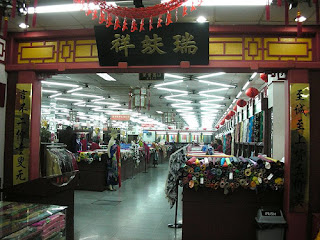Chapter One
Dazhalan in Beijing: Mellowing with Time
Da Zha Lan, also pronounced Da Sha Lanr by Beijing Locals, is another famous Beijing Hutong. It is a 266-meter (291 yards) long commercial street with a history of 500 years, appeared in the Yuan Dynasty, built in the Ming Dynasty, and developed in the Qing Dynasty, it is said that this hutong was originally named Lang Fang Si Tiao.
During the Qing Dynasty, the government built big fences on each of the streets to prevent thieves and robbers during the night. The fence on Lang Fang Si Tiao was much bigger and was preserved longer, so the name of the Hutong was gradually changed to Da Zha Lan which means a big fence.
After more than 500 years of development, the lane has gradually turned into a commercial street with high-rising stores on both sides. Some doggerel verses, such as “If you want to see some playthings, go to Tianqiao”; “If you want to buy something, go to Dazhalan,” and “Majuyuan on head, Neiliansheng on feet, Badaxiang over body, and Sidaheng around waist”, well depict the status and prosperous scene of Dazhalan in old Bejing.
Thankfully, many of the specialty shops still exist. For example, the old Juyuan Hat Shop, now called the Dongsheng Hat Shop, opened in 1811 and specialized in producing official's hats and satin boots for the nobility; and the famous Ruifuxiang Satin, Silk and Fur Shop, which opened in 1893. There are also the Neiliansheng Shoemaker's and the Nanyufeng Tobacco Shop, both more than 100 years old. The Xinrong General Store has a history of 80 years.
Nowadays, everything has changed except for the hustle and bustle on Dazhalan Street. With the removal of feudal dross, Dazhalan has begun to take on a strong commercial atmosphere. Many century-old shops, such as Tongrentang Drug Store, Zhang Yiyuan Teashop, Changchuntang Drug Store, and Yueshengzhai Prepared-meat Shop, have made changes to their shops. Besides, many local snacks have also come to the area, forming a new style of dietary culture.
1. Tongrentang
 |
| Tongrentang |
Tongrentang’s motto may concern some: “that no outsider witnesses the manufacturing process and our sincerity and trustworthiness are left to God’s judgment”, but it has a long history of expertise. Today it sells all manner of herbs, ‘healing’ creatures and drinkable cures, but be sure to have a consultation with a TCM practitioner before you start buying.
2. Ruifuxiang
 |
Ruifuxiang
|
As one of the top brands engaged in the trade of silk fabric in Beijing, Ruifuxiang sells a complete line of silk products, including high-class silk and satins as well as coarse cloth and muslin, colorful cloth and cotton print. Tailored clothing is available as well. The store is always piled high with the best materials in the most beautiful prints.
3. Neiliansheng shoes
 |
Neiliansheng shoes
|
4. Gao Bu Li restaurant
 |
| Gao Bu Li restaurant |
Another reason for Dazhalan’s popularity was the great number of public amusements concentrated here.
There were five large theaters, the Qingleyuan (Celebrating Happiness Playhouse), Sanqingyuan (Three Celebrations Playhouse), Guangdelou (Extensive Virtue Playhouse), Guangheyuan (Extensive Harmony Playhouse) and the Tongleyuan (Common Happiness Playhouse).
When Qing rules made a law prohibiting "uproarious noises in the Inner City areas close to the palace," gentry and rich merchants passed through Qianmen (Front Gate or Zhengyangmen) Gate in the evenings to see plays and operas. These days, people still choose to go to these theaters to watch those old plays and listen to the melodies which will let them enjoy special relax moments.
Throughout the history of old Beijing till today, 36 stores from 11 trades are scattered in Dazhalan, attracting a daily guest-flow of 150,000-160,000, and even more on holidays and weekends.
In China, nearly everyone knows Dazhalan, and even many foreigners have heard about it. All in all, the reason why Dazhalan still exists today in spite of its ups and downs during its 500-odd-year history lies in its own bright specialties. And it will mellow with time to show its greatness from generation to generation.
No comments:
Post a Comment
Thanks for your comment and welcome to China!